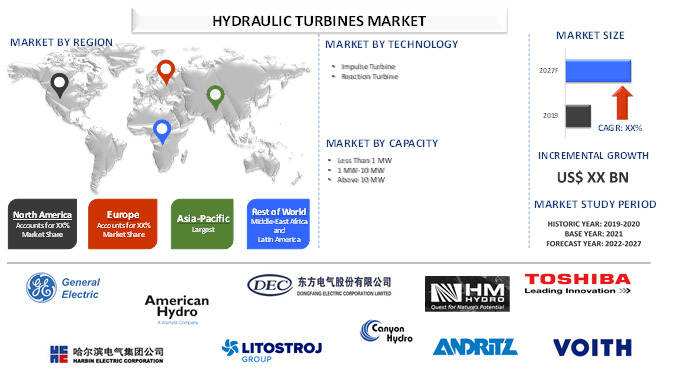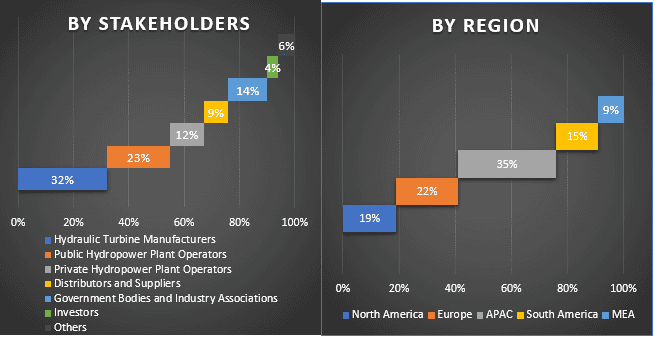水力タービン市場:最新の分析と予測(2021年~2027年)
テクノロジー重視(衝動タービン、反動タービン);容量(1 MW未満、1 MW~10 MW、10 MW超);地域/国

水力タービン市場は、2027年には12億440万米ドルを超える市場評価額に達すると予想され、予測期間(2021年~2027年)中に年平均成長率(CAGR)2.6%で成長すると予想されます。水力タービンは、水の落差からのポテンシャルエネルギーを機械的エネルギーに変換できる装置です。タービンは、その形状と用途において大きく異なることがあります。水力タービンには様々な種類があります。あるタイプは、流量は少ないが落差が大きい純粋な衝動機械です。圧力は機械の固定部と回転部の両方で低下する反動タービンは、幅広い組み合わせをカバーします。水力タービンは、水力エネルギーを機械的エネルギーに変換する機械です。タービンで発生した機械的エネルギーは、タービンの軸に直接結合された発電機を駆動します。発電機は電力を発生させ、これは水力発電としても知られています。一般的に、水力タービンは、特別に設計されたブレードまたはバケットを備えたランナーと呼ばれるホイールで構成されています。水がランナーに当たると、ランナーが回転し、水中に大量の水力エネルギーが存在します。
水力タービン市場の成長の主な理由は、進行中のエネルギー危機と環境汚染です。これらは、化石燃料の過剰な搾取のために、人間の生存と世界の経済成長に対する脅威となっています。化石燃料の最良の代替手段は再生可能エネルギーであり、過去10年間でほとんどの国でますます採用されています。米国エネルギー省によると、2019年の米国の水力発電容量は80.25GWであり、これは同国の総発電量の6.7%を占めていました。水力発電は、特にアフリカのような国では、開発の大きな可能性を秘めており、現在までに水力発電の可能性の10%未満しか活用されていません。水力タービンはエネルギー危機を認識する絶好の機会ですが、水力発電の開発は複雑な課題とリスクをもたらします。貯水池の建設は、時には地域社会全体の移転、広大な土地の浸水、自然の河川システムへの大きな変化につながります。人口の増加など、より高いエネルギー需要につながる他の要因も、水力タービン市場の著しい成長につながっています。
世界の設備容量(MW)

General Electric Company、Andritz、Voith、東芝、日立三菱ハイドロ、American Hydro、Harbin Power Equipment、Canyon Hydro、Dongfang Electric Co. Ltd.、Litostrojは、水力タービン市場で事業を展開している主要なプレーヤーの一部です。これらのプレーヤーは、さまざまな地域でのプレゼンスを高めるために、パートナーシップや契約の獲得とともに、いくつかのM&Aを実施しています。
レポートで提示された洞察
「技術別では、反動タービンセグメントが大きなシェアを占めています」
技術に基づいて、水力タービン市場は、衝動タービンと反動タービンに分割されます。技術の中で、市場の反動タービンセグメントは2020年に9億1,200万米ドルと評価され、2021年から2027年までのCAGR 2.7%で成長し、2027年までに11億780万米ドルに達する可能性があります。
「容量別では、10,000kWを超えるセグメントが大きなシェアを占めています」
容量に基づいて、水力タービン市場は、1MW未満、1~10MW、10MW以上に分割されます。容量の中で、10MWを超えるセグメントは2020年に9億1,850万米ドルの市場評価を占め、分析期間にわたって2.6%のCAGRで2027年までに11億880万米ドルに達すると予想されます。
「アジア太平洋地域は、水力タービン市場の最大の市場の1つです」
水力タービン市場の市場力学をよりよく理解するために、北米(米国、カナダ、北米の残りの地域)、ヨーロッパ(ロシア、ノルウェー、フランス、イタリア、スペイン、ヨーロッパの残りの地域)、APAC(中国、日本、インド、ベトナム、アジア太平洋の残りの地域)、MEA(トルコ、イラン、MEAの残りの地域)、南米(ブラジル、ベネズエラ、コロンビア、南米の残りの地域)を含む、世界中のさまざまな地域で詳細な分析が実施されました。アジア太平洋地域は市場を支配し、地域内の多数の水力発電所により、約43%の市場シェアを獲得しました。
このレポートを購入する理由:
- この調査には、認証された主要な業界専門家によって検証された市場規模と予測分析が含まれています
- レポートは、業界全体のパフォーマンスの簡単なレビューを一目で示します
- レポートは、主要な事業財務、製品ポートフォリオ、拡張戦略、および最近の開発に主な焦点を当てて、著名な業界ピアの詳細な分析をカバーしています
- 業界で普及している推進要因、制約、主要なトレンド、および機会の詳細な調査
- この調査は、さまざまなセグメントにわたる市場を包括的にカバーしています
- 業界の地域レベル分析の深い掘り下げ
カスタマイズオプション:
水力タービン市場は、要件またはその他の市場セグメントに従ってさらにカスタマイズできます。これに加えて、UMIは、お客様が独自のビジネスニーズをお持ちであることを理解しているため、要件に完全に適合するレポートを入手するために、お気軽にご連絡ください。
目次
水力タービン市場の過去の市場分析、現在の市場予測、将来の市場予測は、世界中の主要地域における水力タービンの採用状況を作成し分析するために実施された3つの主要なステップでした。過去の市場数値を収集し、現在の市場規模を推定するために、徹底的な二次調査が実施されました。次に、これらの洞察を検証するために、多数の調査結果と仮定が考慮されました。さらに、水力タービン市場のバリューチェーン全体にわたる業界の専門家との徹底的な一次インタビューも実施されました。一次インタビューを通じて市場数値を仮定および検証した後、トップダウン/ボトムアップアプローチを採用して、市場全体の規模を予測しました。その後、市場の分解とデータ三角測量法を採用して、業界が関係するセグメントとサブセグメントの市場規模を推定および分析しました。詳細な方法論は以下で説明します。
過去の市場規模の分析
ステップ1:二次情報源の詳細な調査:
年次報告書と財務諸表、業績プレゼンテーション、プレスリリースなどの企業内部情報源、およびジャーナル、ニュースと記事、政府刊行物、競合他社の刊行物、セクターレポート、サードパーティデータベース、その他の信頼できる刊行物を含む外部情報源を通じて、水力タービンの過去の市場規模を取得するために、詳細な二次調査が実施されました。
ステップ2:市場セグメンテーション:
水力タービン市場の過去の市場規模を取得した後、主要地域のさまざまなセグメントとサブセグメントの過去の市場の洞察とシェアを収集するために、詳細な二次分析を実施しました。レポートに含まれる主要なセグメントは、技術と容量です。さらに、その地域における水力タービンの全体的な採用状況を評価するために、国レベルの分析を実施しました。
ステップ3:要因分析:
さまざまなセグメントとサブセグメントの過去の市場規模を取得した後、水力タービンの現在の市場規模を推定するために、詳細な要因分析を実施しました。さらに、電力生成の増加と工業化、再生可能エネルギーの採用拡大など、従属変数と独立変数を使用して要因分析を実施しました。世界中の水力タービンセクターにおけるトップパートナーシップ、M&A、事業拡大、製品発売を考慮して、需要と供給側のシナリオについて徹底的な分析を実施しました。
現在の市場規模の推定と予測
現在の市場規模の算定:上記の3つのステップからの実用的な洞察に基づいて、現在の市場規模、水力タービン市場の主要プレーヤー、およびセグメントの市場シェアに到達しました。必要なすべてのパーセンテージシェアの分割と市場の内訳は、上記の二次的アプローチを使用して決定され、一次インタビューを通じて検証されました。
推定と予測:市場の推定と予測のために、ドライバーとトレンド、制約、利害関係者が利用できる機会など、さまざまな要因に重みが割り当てられました。これらの要因を分析した後、関連する予測手法、つまりトップダウン/ボトムアップアプローチを適用して、世界中の主要市場のさまざまなセグメントとサブセグメントについて、2027年頃の市場予測に到達しました。市場規模の推定に採用された調査方法論は次のとおりです。
- 価値(米ドル)で見た業界の市場規模、および国内の主要市場における水力タービンの採用率
- 市場セグメントおよびサブセグメントのすべてのパーセンテージシェア、分割、および内訳
- 提供される製品の観点から見た、水力タービン市場の主要プレーヤー。また、急速に成長する市場で競争するためにこれらのプレーヤーが採用した成長戦略
市場規模とシェアの検証
一次調査:主要地域全体のトップレベルの幹部(CXO / VP、営業部長、マーケティング部長、運営部長、地域部長、カントリーヘッドなど)を含むキーオピニオンリーダー(KOL)との詳細なインタビューが実施されました。次に、一次調査の結果を要約し、述べられた仮説を証明するために統計分析を実施しました。一次調査からのインプットは二次調査の結果と統合され、情報が実用的な洞察に変わりました。
さまざまな地域における一次参加者の分割

市場エンジニアリング
データ三角測量法を採用して、市場全体の推定を完了し、水力タービン市場の各セグメントおよびサブセグメントの正確な統計数値を算出しました。データは、水力タービン市場の種類とその種類に関するさまざまなパラメーターと傾向を調査した後、いくつかのセグメントとサブセグメントに分割されました。
水力タービン市場調査の主な目的
水力タービンの現在および将来の市場動向が調査で特定されました。投資家は、調査で実施された定性的および定量的分析から、投資の裁量に基づいた戦略的洞察を得ることができます。現在および将来の市場動向は、地域レベルでの市場の全体的な魅力を判断し、産業参加者が未開拓の市場を利用して先行者利益として利益を得るためのプラットフォームを提供しました。調査のその他の定量的な目標には、次のようなものがあります。
- 金額(米ドル)で見た水力タービンの現在および予測市場規模を分析します。また、さまざまなセグメントおよびサブセグメントの現在および予測市場規模を分析します
- 調査のセグメントには、種類とそのサブタイプが含まれます
- 水力タービン業界の規制の枠組みを定義および分析します
- さまざまな仲介業者の存在下で、バリューチェーンを分析するとともに、業界の顧客と競合他社の行動を分析します
- 主要地域における水力タービン市場の現在および予測市場規模を分析します
- レポートで調査された主要地域には、北米(米国、カナダ、その他の北米)、ヨーロッパ(ロシア、ノルウェー、フランス、イタリア、スペイン、その他のヨーロッパ)、APAC(中国、日本、インド、ベトナム、その他のアジア太平洋地域)、MEA(トルコ、イラン、その他のMEA)、南米(ブラジル、ベネズエラ、コロンビア、その他の南米)が含まれます。アジア太平洋地域は、この地域で水力発電所が大幅に増加しているため、水力タービン市場を支配しました
- 水力タービン市場の企業プロファイル、および急速に成長する市場で生き残るために市場プレーヤーが採用した成長戦略
業界の地域レベルの分析の詳細
関連 レポート
この商品を購入したお客様はこれも購入しました










